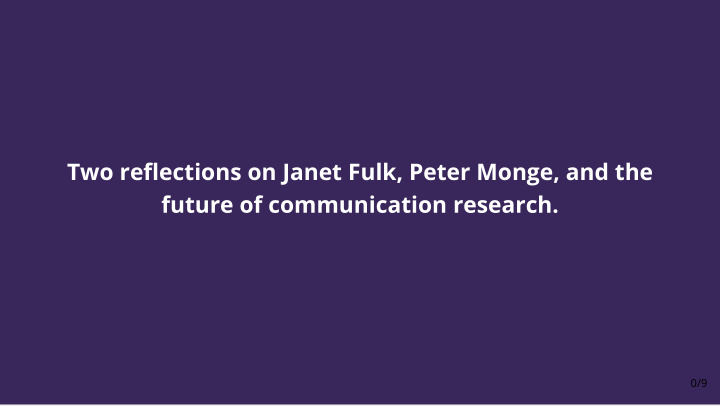



Two reflections on Janet Fulk, Peter Monge, and the future of communication research. 0/9
1/9
2/9
Communal Public Goods 3/9
4/9
. zyxwvutsrqponmlkjihgfedcbaZYXWVUTSRQPONMLKJIHGFEDCBA One zyxwvutsrqponmlkjihgfedcbaZYXWVUTSRQPONMLKJIHGFEDCBA Michael zyxwvutsrqponmlkjihgfedcbaZYXWVUTSRQPONMLKJIHGFEDCBA 60-87 zyxwvutsrqponmlkjihgfedcbaZYXWVUTSRQPONMLKJIHGFEDCBA Communication pp. zyxwvutsrqponmlkjihgfedcbaZYXWVUTSRQPONMLKJIHGFEDCBA Theory Six: Communication Systems zyxwvutsrqponmlkjihgfedcbaZYXWVUTSRQPONMLKJIHGFEDCBA Janet Fulk k February Andrew Flanagin 1996 . Kalman Pages: Peter R. Monge Timothy Ryan Connective and Communal Public Goods in Interactive mass of users that zyxwvutsrqponmlkjihgfedcbaZYXWVUTSRQPONMLKJIHGFEDCBA This paper extends theories of public goods to interactive communication systems. Two key public communication goods are identified. Connectivity 5/9 provides point-to-point communication, and communality links members through commonly held information, such as that often found in databases. These extensions are important, we argue, because communication public goods operate differently from traditional material public goods. These differences have important implications for costs, benefits, and the realization of a critical is necessary for realization of the good. We also explore multifunctional goods that combine various features and hybrid goods that link private goods to public ones. We examine the applicability of two key assumptions of public goods theory to interactive communication systems. First, jointness of supply specifies that consumption of a public good does not diminish its availability to others. Second, impossibility of exclusion stipulates that all members of the public have access to the good. We conclude with suggestions for further theoretical development. Public goods theories grapple with the age-old problem of how to induce collaborative problem solving and other forms of collective action among self-interested individuals, groups, or organizations, assuming, of course, that they share at least some common goals. When successful, such collective action generates so-called public goods, such as parks, roads, libraries, neighborhood brush removal for fire prevention, beach cleanups, or other organized collective goals. Inducing collective action for interorganizational efforts is also a formidable challenge, applied in such diverse arenas as the United Nations, business cartels, conglomera- tions of charitable organizations, the Japanese keiretsu, and health ser- vice provider networks. Possibilities for collective action have expanded with recent advance- ments in information and communication technologies such as electronic mail, cellular telephones, and fax machines as well as the increased avail- ability, complexity, and linkages of database systems, electronic bulletin boards, and other public and private information forums. These new capabilities can, in certain contexts and with appropriate inducements, support electronic communities such as the City of Santa Monica’s Public 60
1. The path to the future of communication research was created by Janet and Peter. 5/9
6/9
DYR D o Y our R esearch 7/9
ATOTI A slo T rue O n T he I nternet 8/9
AAPMDITYA A s A lways P eter M onge D id I t T wenty Y ears A go 9/9
2. When we arrive in the future, Janet and Peter are waiting for us. 9/9
Recommend
More recommend